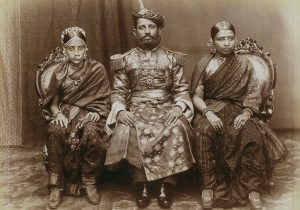 In August 2014 we had the possibility to visit, in Lamego in Northern Portugal, the exhibition of 19th-century photographs relating to Asia, with the title “Journey to the East in the nineteenth century”.
In August 2014 we had the possibility to visit, in Lamego in Northern Portugal, the exhibition of 19th-century photographs relating to Asia, with the title “Journey to the East in the nineteenth century”.
The exhibition comprises 61 photographs that belong to the family Mascarenhas Gaivão, which collected the images, dated between 1880 and 1895 as if they were a Portuguese voyage. The trip begins in Egypt, continues in India (Mumbai, Daman, Nagar Haveli and Goa) and ends in East Timor.
The curator of the exhibition Mr. José Pessoa, responsible for the inventory section of the Museum of Lamego, explained to Lusophone Society of Goa (LSG), that this is an “exceptionally located nucleus of 19th-century photographs that expresses all the magic of photography, in a time when Europe was fascinated with the images of this new medium, which allowed a new knowledge of the planet and of multiple remote cultures “.
José Pessoa elucidated in detail about the technique of photography used in the photos of the exhibition “positive evidence, made from glass negatives by the wet collodion process and printed in proteins”. He however stressed that it is not just the technique that is evident in the breathtaking photographs but that “this is a trip through the East, between 1880 and 1895, at the height of the European discoveries and the allure of the East “.
The exhibition attracted us particularly by some of the photos related to the former Portuguese State of India. Almost unique are those of the Chorão seminary, which was located on the island of the same name. Earlier the seminar was called “Real Colégio de Educação de Chorão“ (Royal College of Education of Chorão)”, where Konkani language was taught to jesuit candidates. As early as 1565 the Jesuits transferred the Novitiate of São Paulo of Old Goa to this place. The Novitiate remained in Chorão until the extinction of the Society of Jesus, which took place in Goa in 1759. It is interesting to know that Fernão Mendes Pinto, the author of the “Peregrinações” (Pilgrimages), professed in this Novitiate in the Church of Nossa Senhora da Graça, where he took the decision to enter the Society of Jesus.
Of great beauty are the photos retouched in colors of natives of Nagar Aveli. José Pessoa also had the patience and kindness to explain to us this ancient staining technique. In 1783, Nagar-Aveli was ceded to the Portuguese, as compensation for the sinking of a Portuguese ship by the Maratha Navy. Later, in 1785, the Portuguese Empire bought Dadra, adding it to the Portuguese State of India. It was the first colony to be disconnected from the Empire when it was occupied by the Indian Union in 1954.
Without wanting to engage more in detail about this amazing exhibition, we didn’t want to finish without referring to the photograph of the King of Sundem with his wives. Maybe some of the readers don’t know this but Goa had a royal clan called Sonda Raja or Soundekar Raja or Rei de Sundem in Portuguese. They were feudal lords who had served the dynasties and empires since the Vijaynagara to the Marathas as well as Adil Shah of Bijapur and finally the Portuguese. The royal house of 250 years, called Shivtirth Palace, is situated in Ponda and the property includes the Temple of Nageshi. In 1907 the King of Sundem sent a letter to King Carlos of Portugal “whose friendship, protection and generosity should be perpetual”.
This exhibition in the large and pleasant space of the Diocesan Museum of Lamego was organized with care by José Pessoa and his team.
Exhibition room Main exhibition room
Left: The Raj of Sundem with his wives. Author: not identified. Technique: printed in proteins. 1884-1894
Right: Dança de Roda. Praganã Nagar-Avely. Author: Adolfo Moniz. Technique: printed in proteins, colored manually. 1884-1894
Aurobindo Xavier (right), president of LSG, talking with José Pessoa, curator of the exhibition. At Lamego









